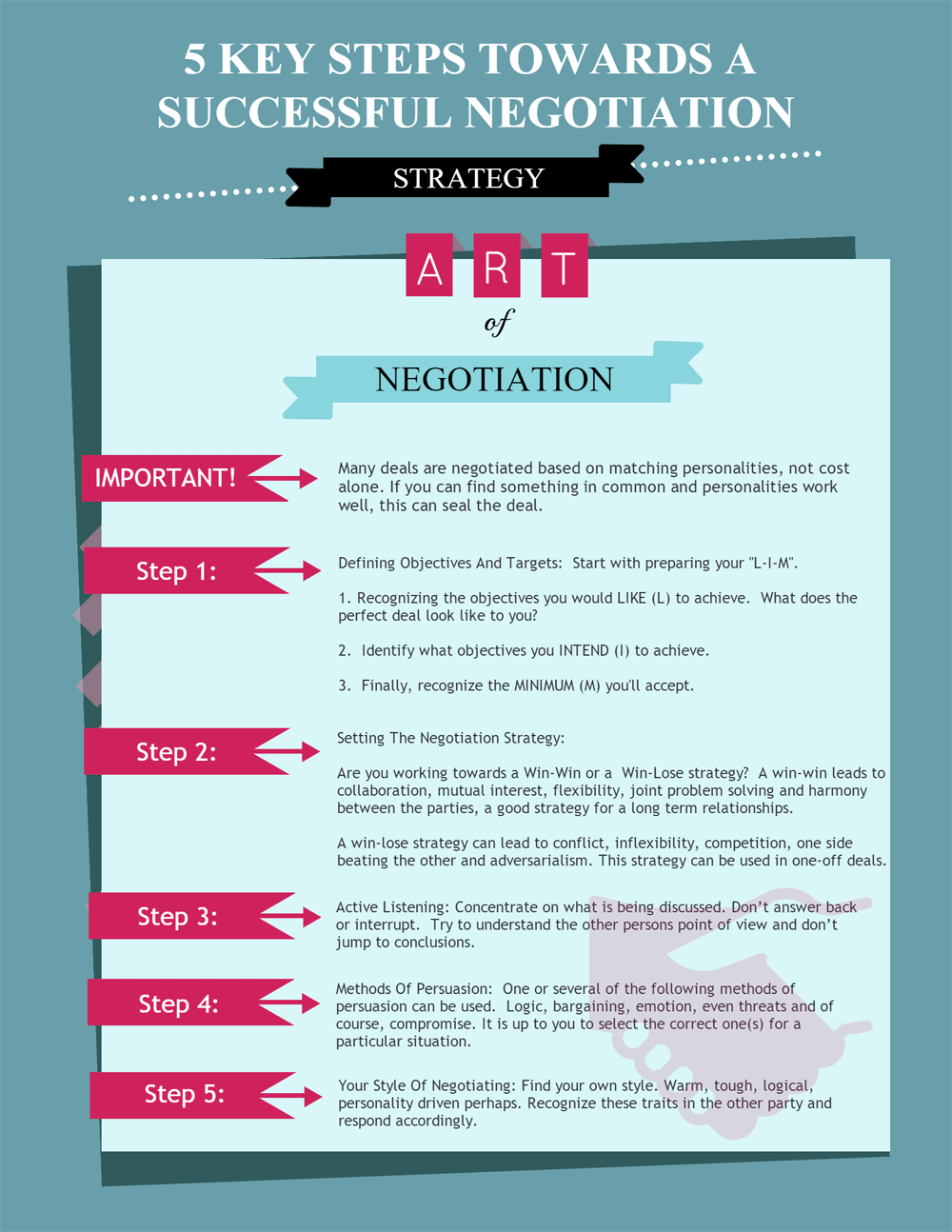Negotiation is a fundamental part of business itself and international trading. You’ll negotiate every part of a deal from sourcing your products from suppliers, dealing with wholesalers and retailers, negotiating price and therefore your profit margin as well as the terms of delivery. Understanding negotiation styles is one of the cornerstones to making any business successful not just importing and exporting.
Negotiation Skills
Deals come in all shapes and sizes but they are really only effective when both sides are happy and create value. Making a deal where you get everything but the other side comes away with nothing, in the long run won’t prove to be effective business negotiations as you could find yourself dealing with someone who’s unmotivated and doesn’t care about losing your business, therefore gives you a terrible or non existent customer service, won’t address your concerns and perhaps cut as many corners as possible to save on their budget, giving you little value.
Effective negotiations works when both sides gain and there’s a compromising style. Both sides are then motivated and want to work together for the long term, working toward conflict resolution and continually trying to better the service and relationship.
Personal Negotiation Strategies
This is really important to understand: Many deals are negotiated based on matching personalities and a collaborative style, not cost alone. If you can find something in common and personalities work well, this can seal the deal and is a much more effective negotiating style.
Negotiating a deal is much easier when you like the person you’re dealing with. Think about how much sense that makes for a second. If you’re negotiating with someone who’s hard headed, stubborn or arrogant and wants only what they want, you probably won’t be that interested in getting the deal done. You’ll see them as someone who’s probably going to cause you a lot of stress and grief as time goes on, which no matter how much money may be on the table, you’ll really have to consider if it’s worth it.
On the other hand, if you’re meeting with someone who’s relaxed and friendly, someone you can meet for a beer and discuss business, this is a much more likable scenario. They still know and understand business but you can see they’ll be good to work with, understanding when things go wrong and someone that will work with you for a solution, this type of person or relationship is much more appealing. Money will always be important but may not always be the priority.
Getting to know the person your negotiating with a little can go a long way.
The Art of Negotiation
Imagine you’ve got a great idea, you’ve spend months researching it, you’ve spent hard earned money getting the idea off the ground. This is now your baby, you’re excited, you love seeing this idea that started in your head, grow and become a reality. The next phase is to meet two suppliers for example.
Approaches to Negotiation
The first is a guy who sits across the desk, asks what you want, looks it up, tells you he can do it, gives you a good price and leaves you to it.
The second is someone that takes the time to grab a coffee with you, wants to hear about how you came up with your idea, what steps you’ve taken to get the project to the point it’s at and wants to know about some of the obstacles you’ve faced. They show an interest in your baby, they show some enthusiasm and excitement and understand your project.
Perhaps they ask what other companies or people you’re working with as they may have a relationship with them as well something that could be a mutual benefit. They ask how you plan to move the project forward, perhaps suggesting they introduce you to a couple of people in their business network that would benefit you as well as ask what problems you foresee in the future to see if they can help combat some of these which already shows and understanding of conflict management.
The price they give you is higher than the first but still just within your budget. Which of those negotiation tactics do you think are better?
A comparison of different negotiation styles but being enthusiastic, taking the time to learn a little goes a long, long way.
Negotiation Training
To embed this infographic, copy and paste the code below:
My Biggest Negotiating Fail
Before we get into more detail, I’ll let you in on my biggest negotiating fail so you don’t make the same mistake I did early on in my career. Learn this lesson and it will save you a lot of stress!
Step 1: Defining Objectives And Targets: Start with preparing your “L-I-M”.
1. Recognizing the objectives you would LIKE (L) to achieve. What does the perfect deal look like to you? Be realistic with this and make sure it’s not totally one sided. As mentioned, you don’t want anyone unmotivated on the other side and this is a key part of negotiation skills training.
2. Identify what objectives you INTEND (I) to achieve. Knowing what your objectives are will keep you focused, don’t lose track of these and make sure these are the prioritised in case you have to sacrifice one or two.
3. Finally, recognize the MINIMUM (M) you’ll accept. Know when you’ll walk away. If you cannot achieve what you need minimally from the deal, there will be no point in continuing the discussion. In these cases, don’t burn your bridges as you never in in future if you can’t do a deal again but be prepared to walk away.
Step 2: Setting The Negotiation Strategy
Are you working towards a Win-Win or a Win-Lose strategy? A win-win leads to collaboration, mutual interest, flexibility, joint problem solving and harmony between the parties, a good strategy for a long term relationships.
A win-lose strategy can lead to conflict, inflexibility, competition, one side beating the other and adversarialism. This strategy can be used effectively in one-off deals but be careful as if you need to come back and do another deal, you may find yourself with the door being shut in your face.
Of the two different negotiating styles, the first will produce a better deal.
Step 3: An Active Listening Negotiation Style
Concentrate on what is being discussed. Don’t answer back or interrupt. Try to understand the other persons point of view and don’t jump to conclusions. Understand what you’re being told and put yourself in their position, try and think from their side how you can bridge the gap.
Collaborative negotiators find more success in achieving what they want with an accommodating negotiation style.
Step 4: Methods Of Persuasion
One or several of the following 5 styles of negotiation can be used, depending on the circumstances:
- Logic: A simple strategy, laying our the facts, the positives, the negatives and talking them through.
- Bargaining Style: We’ve seen this many times on Dragon’s Den! Back and forth trying to find the acceptable middle ground. Using a collaborative negotiation style in general works well as it shows your willingness to work with the other party. Know what you will give up, and feel out what will the other person give up to make a deal. Be realistic with what you’re going to bargain with or the other side may not take you seriously and that could kill the deal.
- Emotion: Someone that likes you will want to work with you. Find what you have in common, sometimes even ask about their family, do you have kids the same age, family that live in the same town. These things can help to find common ground.
- Threats: Not perhaps the best or first course of action but it threats have their place as a conflict negotiation styles go and obviously a competing style to bargaining. If you are the client, you can threaten to take your business elsewhere unless they give you some kind of a better deal. Sometimes there is only so much the other side can do, they cannot sell to you at a lost for a sustained period obviously so use this tactic sensitively and realistically.
- Compromise and Negotiation: Of these five styles of negotiation, find the compromise through dialog is likely the most effective. Chat back and forth, listen and compromise.
Five negotiation styles for you to consider and it’s up to you to select the correct one(s) for the particular situation you’re in. Make sure you have a very good idea of what you want and what you’ll sacrifice before you go into battle but remember, compromise and negotiation is the attitude to have. Winning the battle does not mean you’ll win the war!
Step 5: Style It Out
Find your own style; warm, a little humorous, tough, logical, all business? Negotiations are personality driven and a key leadership skill that you need in business. Personalities will either get along or clash. Find a way to get along and recognize these personality traits in the other party and respond accordingly.
Hopefully some of these techniques will help you put together a collaborative negotiation strategy. These probably aren’t Harvard negotiation styles but they are styles that have come from doing practical business day-to-day with international traders.
Bare in mind, that traders know their business, they know their figures and they know what they can and can’t do and negotiation styles in different countries can vary somewhat, so be open to this. You’ll come to understand this the more you negotiate deals in any particular country.
We’re all out to make a profit, we all need to make a profit so look to negotiate a deal that’s ultimately fair on both sides. This is what works best and will generate longer lasting business relationships.
We would love to hear how you get on or what tips you have for a successful negotiation, so feel free to contact us in the comments below.
Photo by Dylan Gillis on Unsplash




One thought on “Negotiation Styles And Strategies”
Comments are closed.